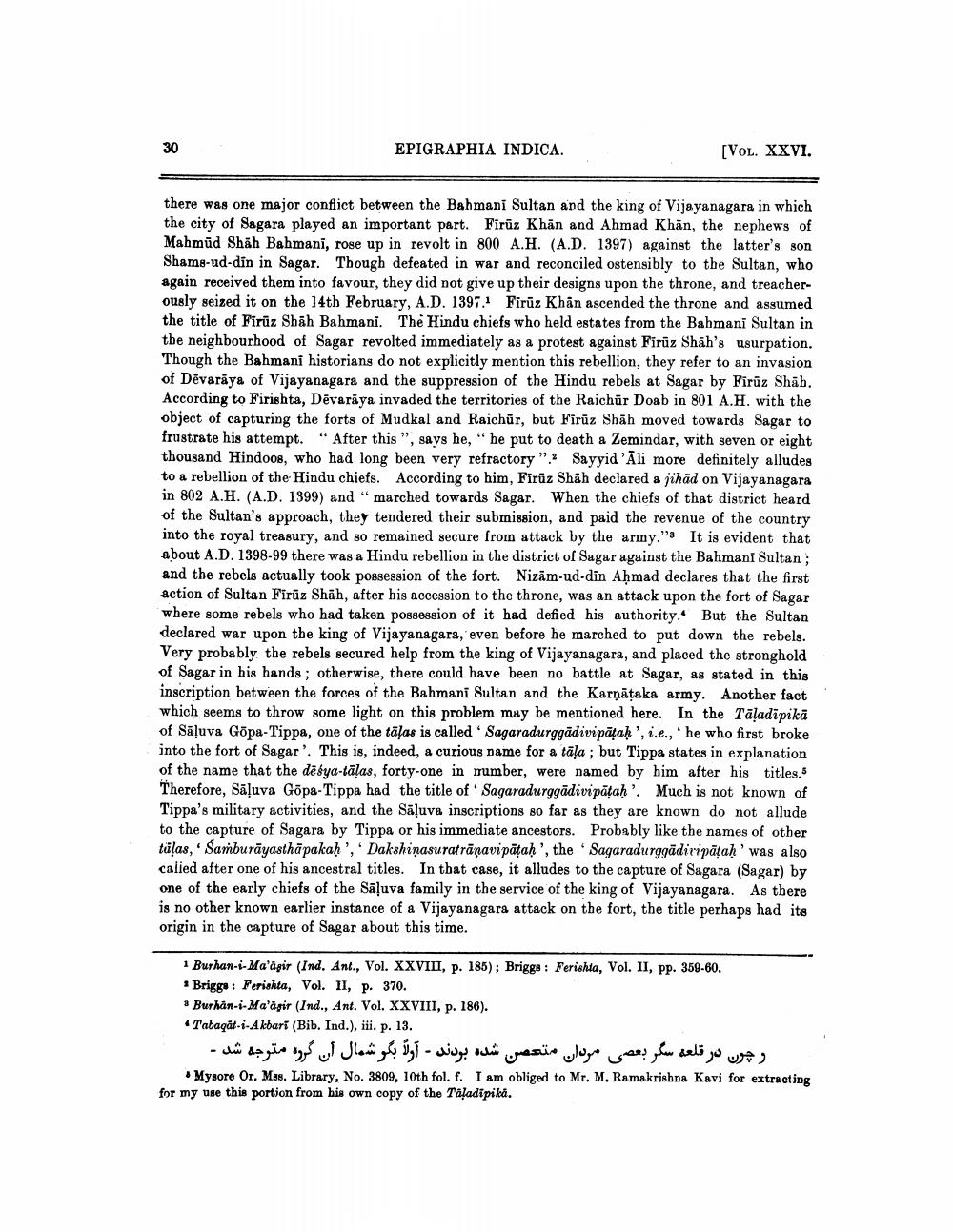________________
EPIGRAPHIA INDICA.
[VOL. XXVI.
there was one major conflict between the Bahmani Sultan and the king of Vijayanagara in which the city of Sagara played an important part. Firüz Khan and Ahmad Khan, the nephews of Mahmud Shāh Bahmani, rose up in revolt in 800 A.H. (A.D. 1397) against the latter's son Shams-ud-din in Sagar. Though defeated in war and reconciled ostensibly to the Sultan, who again received them into favour, they did not give up their designs upon the throne, and treacherously seized it on the 14th February, A.D. 1397.1 Firüz Khan ascended the throne and assumed the title of Firüz Shah Bahmani. The Hindu chiefs who held estates from the Bahmani Sultan in the neighbourhood of Sagar revolted immediately as a protest against Firuz Shāh's usurpation. Though the Bahmani historians do not explicitly mention this rebellion, they refer to an invasion of Devaraya of Vijayanagara and the suppression of the Hindu rebels at Sagar by Firüz Shāh. According to Firishta, Dévariya invaded the territories of the Raichur Doab in 801 A.H. with the object of capturing the forts of Mudkal and Raichûr, but Firüz Shāh moved towards Sagar to frustrate his attempt. "After this ", says he," he put to death a Zemindar, with seven or eight thousand Hindoos, who had long been very refractory "2 Sayyid 'Ali more definitely alludes to a rebellion of the Hindu chiefs. According to him, Firüz Shāh declared a jihād on Vijayanagara in 802 A.H. (A.D. 1399) and "marched towards Sagar. When the chiefs of that district heard of the Sultan's approach, they tendered their submission, and paid the revenue of the country into the royal treasury, and so remained secure from attack by the army." It is evident that about A.D. 1398-99 there was a Hindu rebellion in the district of Sagar against the Bahmani Sultan; and the rebels actually took possession of the fort. Nizām-ud-din Ahmad declares that the first action of Sultan Firuz Shāh, after his accession to the throne, was an attack upon the fort of Sagar where some rebels who had taken possession of it had defied his authority. But the Sultan declared war upon the king of Vijayanagara, even before he marched to put down the rebels. Very probably the rebels secured help from the king of Vijayanagara, and placed the stronghold of Sagar in his hands; otherwise, there could have been no battle at Sagar, as stated in this inscription between the forces of the Bahmani Sultan and the Karnataka army. Another fact which seems to throw some light on this problem may be mentioned here. In the Tāladipika of Sāļuva Gopa-Tippa, one of the tālas is called Sagaradurggādivi pāçak', i.e., he who first broke into the fort of Sagar'. This is, indeed, a curious name for a tāļa ; but Tippa states in explanation of the name that the desya-tālas, forty-one in mumber, were named by him after his titles.5 Therefore, Sāluva Göpa-Tippa had the title of Sagaradurggādivipātah'. Much is not known of Tippa's military activities, and the Sāļuva inscriptions so far as they are known do not allude to the capture of Sagara by Tippa or his immediate ancestors. Probably like the names of other tülas, Samburāyasthäpakah', 'Dakshinasuratrāņavi pātaḥ', the Sagaradurggădiripātah' was also calied after one of his ancestral titles. In that case, it alludes to the capture of Sagara (Sagar) by one of the early chiefs of the Sāļuva family in the service of the king of Vijayanagara. As there is no other known earlier instance of a Vijayanagara attack on the fort, the title perhaps had its origin in the capture of Sagar about this time.
1 Burhan-i-Ma'āşir (Ind. Ant., Vol. XXVIII, p. 185); Briggs : Ferishta, Vol. II, pp. 359-60. * Briggs: Perishta, Vol. II, p. 370. * Burhan-i-Ma'āşir (Ind., Ant. Vol. XXVIII, p. 186). • Tabaqät-i-Akbari (Bib. Ind.), iii. p. 13.
شده بودند - آوا بگو شمال آن گروه متوجه شد -
رچون در قلعه سنگر بعضی مردان متهم
Mysore Or. Mas. Library, No. 3809, 10th fol. f. I am obliged to Mr. M. Ramakrishna Kavi for extracting for my use this portion from his own copy of the Tafadipika.




